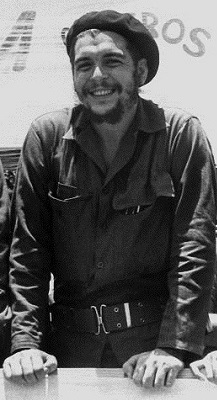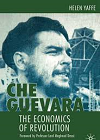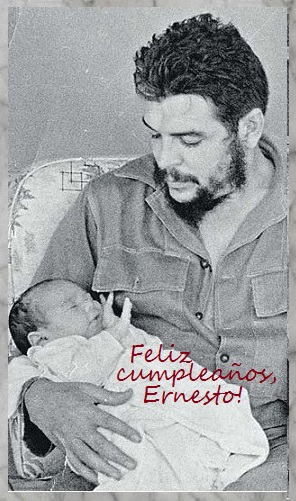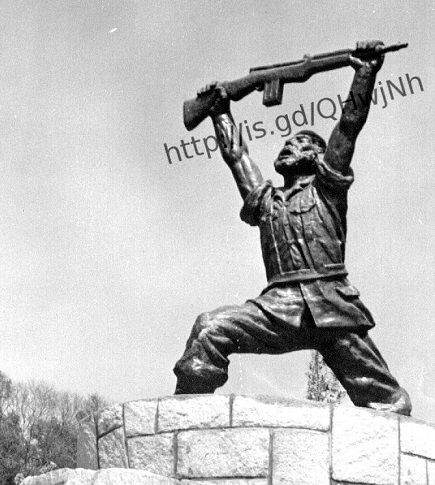|
~ Ernesto Che Guevara
~ Galéria
~ Oldal
~ Bejelentkezés
~ Vissza a Főoldalra
Ernesto Che Guevara, az argentin származású forradalmár, miniszter, gerillavezér és író, Buenos Aires-ben szerzett orvosi diplomát, majd a kubai forradalom során jelentős szerepet játszott a szigetország felszabadításában és újjáépítésében. A kubai gazdaság talpraállításáért dolgozott, küzdött az oktatás és az egészségügy fejlesztéséért, az írástudatlanság és a faji előítéletek felszámolásáért. Saját példájával népszerűsítette az önkéntes munkát. Kongóban és Bolíviában is harcolt - harminckilenc éves volt, amikor az amerikai-bolíviai csapatok csapdába ejtették és kivégezték.
| | |
|

| | |
|
|
|
Book Review – Che Guevara: The Economics of Revolution by Helen Yaffe
|
|
|
 For today, I have found you a great review about Helen Yaffe's book titled Che Guevara: The Economics of Revolution. For today, I have found you a great review about Helen Yaffe's book titled Che Guevara: The Economics of Revolution.
Read it and then you will be looking forward to buying the book.
The majority of literary work focusing on Che Guevara covers either his guerilla activities in Cuba, Congo and Bolivia and the theoretical work he built based on these experiences (Focoism), or his travels through Latin America before he joined Fidel and the 26th of July Movement in Mexico City. This work, however, focuses on what I believe to be the most important role Guevara played in his life: the building of the Cuban economy after the seizure of state power from Batista and the forces of US Imperialism.
In this book, Helen Yaffe documents this period of Guevara’s life, documenting all of his initiatives and how they ultimately tied into his economic management apparatus, the Budgetary Finance System (BFS), which was developed as an alternative to, and a critique of, the Soviet bloc’s Auto-Financing System (AFS).
Far removed from the typical image of Guevara as a “romantic” revolutionary, Che as Minister of the Minstry of Industries (MININD) is depicted as an utterly pragmatic man, willing to use any administrative technique or technology, regardless of the ideology that “birthed” it (“it’s not important who invented the system. The accounting system that they apply in the Soviet Union was also invented under capitalism.”). The US Corporations that existed in Cuba before the revolution are shown to have been a major influence on Guevara’s own administrative organization in the Ministry of Industries. These corporations, Guevara thought, represented capitalism at a much more advanced stage than what existed in Russia before the October Revolution. “He was,” states Yaffe, “impressed with their management structures, the use of centralised bank accounts and budgets, determinate levels of responsibility and decision-making, and departments for organisation and inspection.”
Throughout, this book documents the mind-numbingly immense amount of work that Che did during his tenure as the first Minister of MININD (very often not sleeping for days at a time). From the early, crisis-ridden days of the revolution when he struggled to find administrators for the factories in the wake of the mass exodus of the upper echelons of Cuban society after it became apparent the revolution was aimed at building Socialism (at one point, Fidel and he even resorted to employing children from a boarding school training to become teachers as temporary administrators for 200 factories that had just been nationalized), on to the relatively more stable days of the mid-60′s when increasing productivity and lowering costs while undermining the law of value and defeating the anarchy of the market with centralized planning were his main concerns, Che is shown as a tireless revolutionary, who always sought to lead the Cuban workers by example, to show them both why they needed to build Socialism, and how they could go about it.
My only real gripe with this work is that, at times, Yaffe isn’t as critical of Che as she should be. There are times when for whatever reason, some of his initiatives failed to meet expectations. Unless Che himself was self-critical at these times (or even when he was) Yaffe seems to try to make excuses for him, to show that it really wasn’t his fault at all that such and such plan failed. While this isn’t a very big issue (she only really does it at a couple of points), it did detract from an otherwise superb work.
Overall, this is a book that I think is of vital importance to anyone who is interested in the building of an alternative economic model to Capitalism, and wants to study the historic attempts at such an endeavour, as well as anyone interested in seeing how modern Cuba came to be how it is today. Many of the interviews Yaffe conducted for this work were done with now very aged contemporaries and comrades of Che, so it is great that this work was done when it was – another decade, and a work like this might very well have been impossible.
Source
|
|
|


| 2014.02.24. 00:05, Aleida |
Feliz cumpleaños, Ernesto!
|
 Ernesto Guevara March, Che legfiatalabb gyermeke, ma ünnepli 49. születésnapját! Ernesto Guevara March, Che legfiatalabb gyermeke, ma ünnepli 49. születésnapját!
Feliz cumpleaños, Ernesto!
Két testvérével, Aleida-val és Camilo-val ellentétben ő nagyon visszahúzódó életet él, Kubában ritkán találkozhatnak az arcával a médiában.
Legutolsó aktuális fényképe még 2011-ből való, amelyen nagybátyja, Juan Martín Guevara de la Serna (Che legfiatalabb testvére) mosolyog mellette. [megnézem a képet]
Ernesto Guevara March, Che's youngest child, celebrates his 49th birthday today!
Feliz cumpleaños, Ernesto!
Unlike his siblings, Aleida and Camilo, he lives a really reserved life, it is a rare occasion to see his face in the Cuban media.
His latest photo was taken in 2011 where he is smiling beside his uncle, Juan Martín Guevara de la Serna (Che's youngest sibling). [check it out]
|
|
|
|
|
| 2014.02.24. 00:00, Aleida |
Che Guevara első szobra
|
 San Miguel, Santiago, Chile San Miguel, Santiago, Chile
Che Guevara első szobrát, amelyet az emlékére emeltek a világon, 1970. november 8-án avatták fel - a polgármester, Tito Palestro Rojas javaslatára.
A szobrot Praxíteles Vázquez alkotta meg, a talapzatot három építész, Gastón Jobet, Raúl Bonnefoy és Guaraní Pereda tervezte. 300.000 escudo-ba került (1.500.000 chilei peso) és 1400 kilót nyomott.
A bronzszobrot 1973. április 22-én robbantották fel a chilei fasiszták Augusto Pinochet Ugarte uralma alatt.
További képeket láthatsz a szoborról itt: [Galéria]
|
|
San Miguel, Santiago, Chile
Che Guevara's first statue in the world was erected on 8th November 1970 - by the idea of the mayor, Tito Palestro Rojas.
It was created by the sculptor, Praxíteles Vázquez and the base was designed by the architects, Gastón Jobet, Raúl Bonnefoy and Guaraní Pereda. It cost 300,000 escudos (1,500,000, Chilean pesos) and it weighed 1,400 kilos.
The bronze statue was blown up and destroyed on 22 April 1973 by the Chilean fascist dictatorship, led by General Augusto Pinochet Ugarte.
You can check out more photos of the statue: [Gallery]
|
|
|


| 2014.02.22. 00:00, Aleida |
Guevara's hands (Russian poem)
|
Kedves orosz barátom, Aiya felhívta a figyelmemet egy orosz versre, amelynek témája Che Guevara (Jevgenyij Dolmatovszkij: Guevara kezei) és ma ezt a költeményt szeretném megosztani veletek.
A probléma "annyi", hogy kizárólag oroszul található meg az interneten, így csupán azok élvezhetik, akik beszélik a nyelvet. Sajnos az én orosztudásom meglehetősen szegényes, viszont remélhetőleg Aiya vagy valamelyik oroszul tudó látogatóm majd egyszer segít lefordítani.
Mivel a vers elég hosszú, így ketté kellett osztanom:
~ Guevara's hands (Russian poem)
~ Guevara's hands (Russian poem) II.
|
|
My lovely friend, Aiya called my attention to a Russian poem whose topic is Che Guevara (Jevgenyij Dolmatovszkij: Guevara's hands) and today I would like to share it with you.
The problem is that it is available only in Russian, so only those people can enjoy it who speak Russian well. Unfortunately my Russian is really poor, however I do hope that one day Aiya or one of my visitors speaking Russian will be able to translate it.
As the poem is really long, I had to divide it into two:
~ Guevara's hands (Russian poem)
~ Guevara's hands (Russian poem) II.
|
|
|


| 2014.02.21. 12:45, Aleida |
Che Guevara speaking French
|
Néhány nappal ezelőtt egy barátnőmmel arról beszélgettünk, milyen nyelveken beszélt Che Guevara.
Az anyanyelve, a spanyol mellett tudjuk, hogy beszélt franciául, hiszen az édesanyja megtanította neki a nyelvet még kicsi korában, amikor az asztmája miatt nem járhatott iskolába a többi gyerekkel.
Azt is tudjuk, hogy tanult szuahéliül (amikor Kongóban harcolt) és a kecsua nyelvvel is megpróbálkozott (amikor Bolíviában harcolt). A második dél-amerikai útja során az angol nyelvvel foglalkozott, de saját bevallása szerint nem tett szert nagy előrehaladásra.
Bizonyítékként mindössze két videofilmet találtam, amelyeken Che francia nyelven beszél:
~ Che beszéde Algériában (1963) [megnézem]
~ Egy, Franciaországban készült interjú (1964) [megnézem]
|
|
A few days ago I was talking to one of my friends about the topic: which languages did Che Guevara speak?
Besides his native language, Spanish, we know that he spoke French, as his mother taught him this language when he was little, when he couldn't go to school with the other children because of his asthma.
We also know that he studied Swahili (when he was fighting in the Congo) and Quetchua (when he was fighting in Bolivia). During his second Latin American journey he dealt with the English language, but according to his own confession, he didn't make a big progress.
As a proof, I have found two videos on which Che was speaking French:
~ Che's speech in Algeria (1963) [check it out]
~ An interview, made in France (1964) [check it out]
|
|
|


| 2014.02.20. 22:23, Aleida |
| | |
|
|
|
~ Ernesto Che Guevara
~ Gallery
~ Site
~ Log in
~ Back to the Main page
Ernesto Che Guevara, the Argentine-born revolutionary, minister, guerrilla leader and writer, received his medical degree in Buenos Aires, then played an essential part in the Cuban Revolution in liberating and rebuilding the country. He did his best to set up the Cuban economy, fought for the improvement of the education and the health system, the elimination of illiteracy and racial prejudice. He promoted voluntary work by his own example. He fought in the Congo and in Bolivia - he was thirty-nine years old, when he was trapped and executed by the joint American-Bolivian forces.
| | |
|
|

